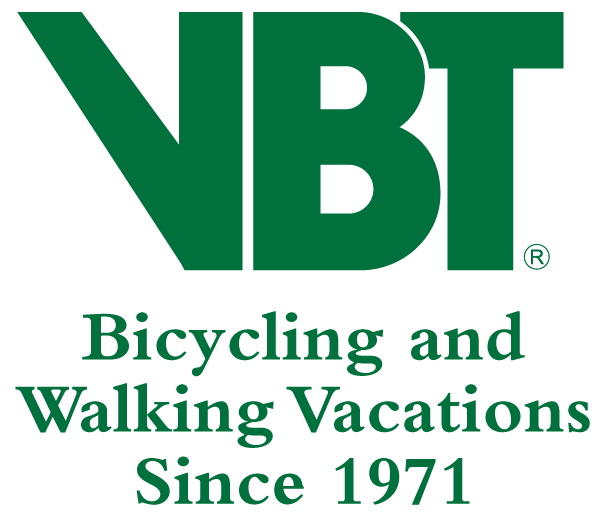by Mary Lauran Hall
on April 29, 2014
 The Alliance recently traveled to Baltimore to lead a Winning Campaigns Training with Bikemore. We’re taking a look at some of the most interesting campaigns that advocates planned at the training. Today, let’s take a look at a push to win bike funding in Richmond. The Alliance recently traveled to Baltimore to lead a Winning Campaigns Training with Bikemore. We’re taking a look at some of the most interesting campaigns that advocates planned at the training. Today, let’s take a look at a push to win bike funding in Richmond.
Max Hepp-Buchanan drove up to the Baltimore training from Richmond, VA, where he directs Bike Walk RVA at Richmond Sports Backers. Together with his colleague Brantley Tyndall, Max plotted out Connect RVA — a campaign to secure city funding for over 20 miles of on-street bicycle infrastructure in time for September 2015, when Richmond will host the UCI Road World Championships.

Richmond advocates are working to build out a sophisticated bike network in the city. Image: Richmond Sports Backers
“We’re lobbying city council to put in $3 million for on-street bike lanes and $3.5 million to fully find a bike bridge over the James River,” explained Max.
Those funds will be used for a mix of infrastructure from the city’s bicycle master plan, which is currently under development. “There are some protected bike lanes proposed for the downtown core, a big bicycle boulevard through one of our densest neighborhoods, and a bunch of standard and buffered bike lanes,” Max said.
The Connect RVA campaign is already up and rolling, and advocates have already benefitted from an injection of funding from Advocacy Advance. Sports Backers received a Rapid Response grant to make a pamphlet and postcard about Connect RVA.
The postcards double as an advocacy tactic: a supporter can write their address on a postcard, and Sports Backers staff send them to the appropriate council member. So far, city council has received over 70 postcards and 400 emails in support of increased bike infrastructure funding.

Richmond advocates created these tactical postcards with support from an Advocacy Advance Rapid Response grant. Image: Richmond Sport Backers
Max is no stranger to bike advocacy. Before moving to Richmond to work with Sports Backers, he served on the advocacy team at Cascade Bicycle Club in Seattle. But even with years of advocacy under his belt, he found strategizing at the Winning Campaigns Training in Baltimore “really helpful.”
“Going through short, medium, and long, term goals is really important,” Max said. He appreciated “learning how to target key decision makers and not go after all city council members, but targeting tactics towards them.” After to the Training, Max and Brantley started focusing on the two city council members who could be champions for this policy.
Congrats on your new campaign plan, Max and Brantley! We look forward to seeing great things in Richmond.

People in Richmond love getting around by bike – and would like better routes on for biking. Image: Richmond Sports Backers
by Mary Lauran Hall
on April 28, 2014
 This fall, Baltimore City will welcome a protected bike lane along Maryland Avenue, a north-south route. But before the city even breaks ground, advocates are already hard at work planning an east-west lane to fill out the network. This fall, Baltimore City will welcome a protected bike lane along Maryland Avenue, a north-south route. But before the city even breaks ground, advocates are already hard at work planning an east-west lane to fill out the network.
The leader behind this effort is Chris Merriam. He’s the executive director at Bikemore, which is Baltimore City’s (expertly named) local bike advocacy organization. The Alliance recently traveled to Bikemore’s turf to lead a Winning Campaigns Training, where 20 advocates from around the eastern seaboard plotted out efforts to make biking and walking better in their communities.
Over the coming week, we’ll be taking a look at a few of the great campaigns that came out of the Baltimore training. Today, let’s focus on Bikemore’s campaign to win a protected bike lane on Pratt Street, a major east-west thoroughfare in the city.
“Pratt starts in West Baltimore, connects to a bike lane on the West side, goes through downtown, and heads towards the east around Patterson Park, which is one of the major urban parks in Baltimore,” Chris explained.
Pratt Street intersects with Maryland Avenue, where a new protected bike lane is planned. “With the Maryland Avenue cycle track going in by this fall, we’re going to have the north-south backbone of a really great protected bike lane network,” said Chris. An east-west route on Pratt Street would further build out that network.

The protected bike lane on Maryland Avenue will be modeled after Washington, DC's 15th Street cycletrack. Image: ASLA
At the Alliance Winning Campaigns Training, Chris and others from Bikemore drafted a strategic game plan to organize public support and influence the key decision makers who could approve a protected bike lane on Pratt Street. By the end of the training, Bikemore had a blueprint for the new cycle track campaign.
This wasn’t Chris’ first time at a Winning Campaigns Training. In fact, the Maryland Avenue protected bike lane was a product of an earlier Training in Boston. Chris found the training in Boston incredibly helpful. “The general principles of what we learned in terms of how to do outreach, how to engage different stakeholders was invaluable,” he said. “The exercise of actually planning out the campaign in a visual, logical, step-by-step way was instrumental in getting our ideas organized for action steps. We were able to plan out our work and say ‘here’s what we’re going to do. Let’s do this.’ And we did.”
With the Maryland Avenue protected bike lane close to a full win, Chris wanted to hold Winning Campaigns Training in Baltimore to share the knowledge he gained in Boston with other advocates in the Bikemore network.
“There are a lot of people with a lot of potential to be good advocates. Bikemore can’t do everything, and there’s a lot of advocacy to be done. Our hope was to bring promising people on board to do their own advocacy, which [Bikemore] could sign onto,” Chris explained.
Kudos, Chris and Bikemore! We can’t wait to see the fruits of your efforts.
by Mary Lauran Hall
on April 25, 2014
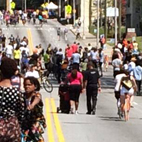 Welcome to the Alliance's weekly roundup of state & local biking & walking advocacy news. Every week, we crawl the blogs of our member organizations and bring you the most interesting tidbits. Welcome to the Alliance's weekly roundup of state & local biking & walking advocacy news. Every week, we crawl the blogs of our member organizations and bring you the most interesting tidbits.
BIKE TO WORK DAY AHOY!

This week, our members are busy prepping for Bike Month and Bike to Work Day.
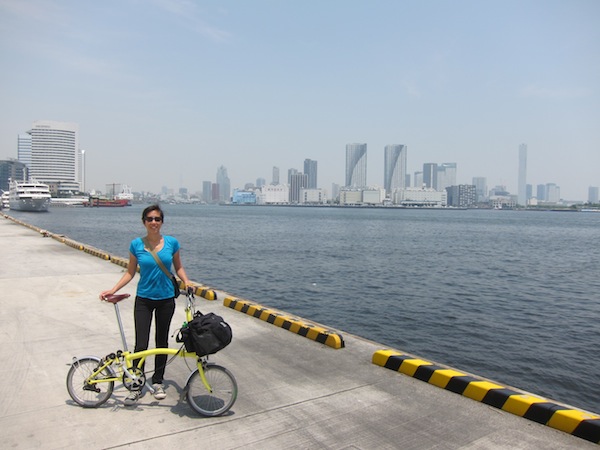
Keep reading after the jump.
by Mike Samuelson
on April 22, 2014
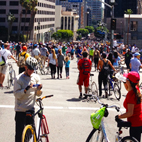 In 2005, Open Streets only took place in 10 cities across the continent. Now, the number of Open Streets in the United States, Canada, and Mexico has swelled to over 100.
by Mary Lauran Hall
on April 21, 2014
 If your community gets a lot of rain and snow, are people be less likely to bike or walk? If your community gets a lot of rain and snow, are people be less likely to bike or walk?
On first blush, an answer might seem obvious. Most people would probably choose to stay warm and dry instead of getting wet and cold. The wetter a place is, the less likely people will be to bike and walk, right?
Well, no. The data tell a different story. According to the 2014 Alliance Benchmarking Report, there's actually a pretty weak relationship between average annual precipitation and the percentage of the population that walks or bikes to work. The below chart the relationship between average annual inches precipitation (grey line) and the percentage of the population that walks or bicycles to work (orange dots) in the 52 most populous cities:

The data are all over the map. Some rainy, snowy cities see a lot of active commuting while others see less; some dry places see higher amounts of active commuting; a lot of these places see less. For example, about 17% of people bike or walk to work in my beloved wet and cold hometown of Boston. Meanwhile, in sunny, warm, and dry Tucson, only about 7% of people bike or walk to work. There just isn't a clear trend.
In celebration of these new data -- and in the spirit of welcoming the most famously drizzly month of the year -- the Alliance is teaming up with Ortlieb and Streetsblog to hold a Showers & Snow photo contest. Pull on those wellies, dig out your camera umbrella, and sort through your winter photos, shuttersnappers!

Show us your photos of people walking and bicycling in the rain and snow, and we'll give the photographers of the two best images brand new sets of waterproof panniers from Ortlieb. As the proud owner of a pair of Ortlieb panniers, I can guarantee that these beauties will keep your stuff dry as Las Vegas in the summertime.

Keep reading after the jump for details.
by Mary Lauran Hall
on April 17, 2014
 Welcome to the Alliance's weekly roundup of state & local biking & walking advocacy news. Every week, we crawl the blogs of our member organizations and bring you the most interesting tidbits. Welcome to the Alliance's weekly roundup of state & local biking & walking advocacy news. Every week, we crawl the blogs of our member organizations and bring you the most interesting tidbits.
BENCHES HAVE BEEN MARKED.

This week saw the release of the 2014 Alliance Benchmarking Report, the biennial CDC study to analyze data on biking & walking in all U.S. states, the 52 largest cities, and (new this year) 17 midsized cities. It's comprehensive; it's a behemouth; it's a transportation nerd's dream come true. Download it here.
Pittsbugh advocates are excited that the report includes data on the City of Bridges.
Kansas City, MO is movin' on up in biking and walking rates.
Georgia Bikes is fascinated by 8 fascinating facts.
BikeWalkLee laments that Florida comes in last for biking and walking fatality rates. Room for improvement, y'all.
Keep reading to see more stories from around the biking & walking advocacy world.
by Christy Kwan
on April 16, 2014
 Last week, the Advocacy Advance team joined the Hawaii Bicycling League and the Oahu Metropolitan Planning Organization (OahuMPO) for a Navigating MAP-21 Workshop in Honolulu. Last week, the Advocacy Advance team joined the Hawaii Bicycling League and the Oahu Metropolitan Planning Organization (OahuMPO) for a Navigating MAP-21 Workshop in Honolulu.
Given the great weather nearly year-round, it's no surprise that Hawaiians want to live in communities where walking and bicycling are safe, easy, and accessible. But all too often, roads remain unsafe while millions of dollars in potential federal funding for active transportation remain untapped.
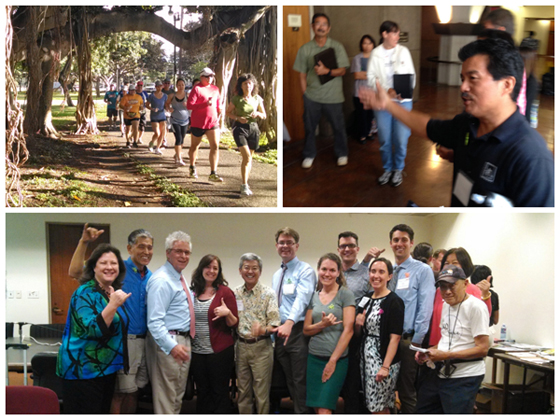
In fact, Hawaii has yet to set up the Transportation Alternatives Program -- a federal funding program that could provide the state with $3.6 million for biking and walking in fiscal year 2014. Enter Advocacy Advance's Navigating MAP-21 Workshop, a session to teach public officials, advocates, elected officials, and community members how to access federal active transportation funding.
by Mary Lauran Hall
on April 16, 2014
 Today marks the release of the brand new 2014 Alliance Benchmarking Report, a massive compendium of data and research on walking and bicycling in all 50 states, 52 of the most populous cities, and 17 midsized cities. Today marks the release of the brand new 2014 Alliance Benchmarking Report, a massive compendium of data and research on walking and bicycling in all 50 states, 52 of the most populous cities, and 17 midsized cities.
The Alliance produces the Benchmarking Report every two years in partnership with the Centers for Disease Control and Prevention's Healthy Community Design Initiative. Our goal: to comprehensively examine bicycling and walking transportation across the U.S. and how these trends relate to public health, safety, and social and economic well being.
Want to check it out for yourself? Download the report here.
Download the
2014 Report
There’s a TON of really fascinating data in this year’s Alliance Benchmarking Report. Here’s our peek at the eight most interesting data points.
1. We're seeing small but steady increases in the number of people biking and walking to work.
The average large American city experienced a 5.9% increase in population from 2000 to 2010 without comparable increases in land mass, and budgets are tight across the board. Both of these factors point to a need to find cost-effective modes of transportation that move people without taking up more space.
Enter bicycling and walking. Walkers and bikers take up very small amounts of road and parking space, and the associated infrastructure is cheap: Portland built an entire network of bike lanes for roughly the same amount of money that it would have taken to build single mile of urban highway.
It's tough to measure just how many people walk and bike in the U.S. -- the best numbers we have come from the American Communities Survey, which only asks about trips to work -- but we're still seeing slow, steady increases in walking and biking.

Keep reading after the jump.
by Brent Buice
on April 14, 2014
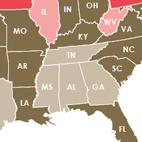
Guest post by Brent Buice, Executive Director of Georgia Bikes
Several years ago at the National Bike Summit, a casual conversation between the Executive Directors of Bike Texas and the Florida Bicycle Association seeded an idea that grew and matured into the recent, first-ever Southern States Caucus Regional Retreat.
That conversation, along with similar discussions between Georgia Bikes and Alliance staff, recognized that the South is indeed different, y’all.
While those of us working on bicycle advocacy in southern states listen admiringly to the accomplishments of our colleagues in Oregon, Delaware, Colorado, and Minnesota, we can’t help but feel a little bit “outside the club.” In short, we know that, despite recent victories, we have a very, very long way to go, and we can’t realize our vision without honestly assessing the social, political, and geographic realities of where we do our work.
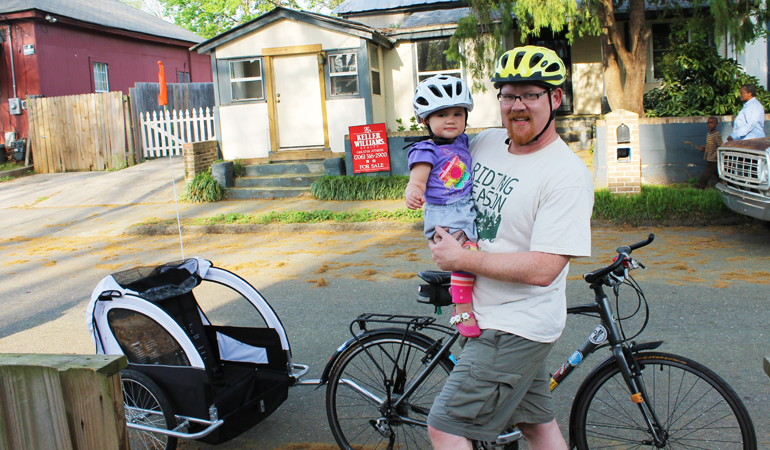
Brent Buice with his daughter, Lily. Photo: Brent Buice / Alliance for Biking & Walking
We also know that there is a lot of opportunity - and interest - in creating a bike friendly South. Our region’s obesity statistics stand in stark contrast to our enviable climate and diverse, breathtaking landscapes: the serene Appalachian mountains, the distinctive Gulf and Atlantic coasts, and romantic, antebellum cities that cry out to be explored by bicycle.
by Mary Lauran Hall
on April 04, 2014
 Welcome to the Alliance's weekly roundup of state & local biking & walking advocacy news. Every week, we crawl the blogs of our member organizations and bring you the most interesting tidbits. Welcome to the Alliance's weekly roundup of state & local biking & walking advocacy news. Every week, we crawl the blogs of our member organizations and bring you the most interesting tidbits.
MARK THOSE BENCHES!
The 2014 Alliance Benchmarking Report will be released on April 16. Get a sneak peek at this webinar.
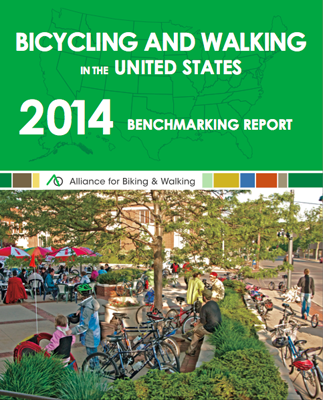
APRIL FOOLIN'
An Austrian study found that wearing costumes vastly improves bicyclist safety. Chicken suits are especially effective.
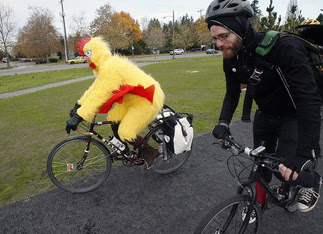
The Active Transportation Alliance will launch Skivvy, a bike sharing system for riding in your underpants.
|
|

 State and local advocates are growing biking and walking in North America. Slowly but surely, our communities are becoming safer and more accessible for everybody.
State and local advocates are growing biking and walking in North America. Slowly but surely, our communities are becoming safer and more accessible for everybody.  The Alliance recently traveled to Baltimore to lead a
The Alliance recently traveled to Baltimore to lead a 


 This fall, Baltimore City will welcome a protected bike lane along Maryland Avenue, a north-south route. But before the city even breaks ground, advocates are already hard at work planning an east-west lane to fill out the network.
This fall, Baltimore City will welcome a protected bike lane along Maryland Avenue, a north-south route. But before the city even breaks ground, advocates are already hard at work planning an east-west lane to fill out the network.
 Welcome to the Alliance's weekly roundup of state & local biking & walking advocacy news. Every week, we crawl the blogs of our member organizations and bring you the most interesting tidbits.
Welcome to the Alliance's weekly roundup of state & local biking & walking advocacy news. Every week, we crawl the blogs of our member organizations and bring you the most interesting tidbits. 

 In 2005, Open Streets only took place in 10 cities across the continent. Now, the number of Open Streets in the United States, Canada, and Mexico has swelled to over 100.
In 2005, Open Streets only took place in 10 cities across the continent. Now, the number of Open Streets in the United States, Canada, and Mexico has swelled to over 100.  If your community gets a lot of rain and snow, are people be less likely to bike or walk?
If your community gets a lot of rain and snow, are people be less likely to bike or walk?


 Welcome to the Alliance's weekly roundup of state & local biking & walking advocacy news. Every week, we crawl the blogs of our member organizations and bring you the most interesting tidbits.
Welcome to the Alliance's weekly roundup of state & local biking & walking advocacy news. Every week, we crawl the blogs of our member organizations and bring you the most interesting tidbits. 
 Last week, the Advocacy Advance team joined the
Last week, the Advocacy Advance team joined the 
 Today marks the release of the brand new 2014 Alliance Benchmarking Report, a massive compendium of data and research on walking and bicycling in all 50 states, 52 of the most populous cities, and 17 midsized cities.
Today marks the release of the brand new 2014 Alliance Benchmarking Report, a massive compendium of data and research on walking and bicycling in all 50 states, 52 of the most populous cities, and 17 midsized cities.


 Welcome to the Alliance's weekly roundup of state & local biking & walking advocacy news. Every week, we crawl the blogs of our member organizations and bring you the most interesting tidbits.
Welcome to the Alliance's weekly roundup of state & local biking & walking advocacy news. Every week, we crawl the blogs of our member organizations and bring you the most interesting tidbits. 





